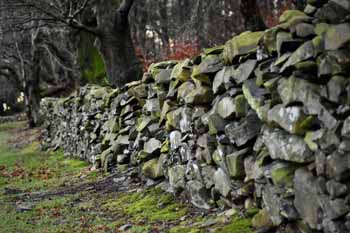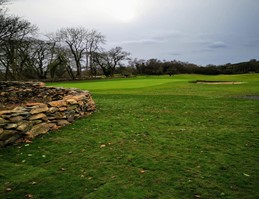How Clandeboye Golf Club romances the stone
The estate that’s home to Clandeboye Golf Club’s two courses contains up to 15 miles of dry stone walls. In the last century, sections of them have collapsed and they’ve been overgrown with vegetation. Here, club captain Owen Trainor and club manager Geoff Johnson MBE, detail how a group of members meet every Monday, and have done now for years, to restore this beautiful part of the landscape.
Nestled within the North Down countryside in Northern Ireland lies the historic Clandeboye Estate, and within that rests the exquisite Clandeboye Golf Club.

The Clandeboye Estate dates back to 1674 but is most famous for the legacy of its first Marquess (1826-1902), who laid out the historic parklands under the guidance of James Fraser. The project was so extensive that the estate still boasts the largest area of woodland in Northern Ireland.
The golf club has two fabulous courses, The Dufferin and The Ava. The two courses take their name from the Marquess of Dufferin and Ava. The title Clandeboye derives from the Irish language name for the ancient O’Neill chieftain, Blond (Aodh) O’Neill, whose kingdom included the northern part of County Down. Ava was the ancient capital of Burma, and the Marquess, a leading diplomat of his time, as Viceroy of India who bloodlessly annexed Upper Burma in 1885 for the British Empire under Queen Victoria.
While Clandeboye GC is a private members’ club with about 1,200 members, it shares space with the wider Clandeboye Estate, and the Ulster Way meanders along laneways throughout both courses and is constantly used by locals, visitors, groups, bikers, joggers and dog walkers.

Lady Dufferin
Many walkers make their way to see a local landmark, Helens Tower, and enjoy the spectacular views out over Belfast Lough and over to Scotland. The club facilitates all these groups providing car parking, use of a shoe cleaning station and a welcoming attitude that pervades throughout the complex.
Originally, as part of a working estate, the land that now accommodates the golf courses contains reputedly up to 15 miles of dry stone walls. Dry stone, sometimes called drystack, is in Scotland a building method by which structures are constructed from stones without any mortar to bind them together. Dry stone walls are characteristic of upland Britain and Ireland where rock outcrops naturally or large stones exist in quantity in the soil. Some dry stone wall constructions in north-west Europe have been dated back to the Neolithic Age. The oldest dry stone walls in Ireland are the Céide fields of County Mayo, built approximately 5,800 years ago.

The dry stone walls on Clandeboye Golf Club are built of local stone, predominantly carboniferous limestone, very old stones from the Ice Age which are naturally rounded in shape. Legend has it that in dry stone walling, you should never touch a stone twice, you should pick it up and intuitively know where to place it down – and find a suitable spot for it to remain there forever. However, while Clandeboye’s stonewallers have learned much through experience and trial and error, they won’t claim never to have touched each stone once only!
Clandeboye dry stone walls feature prominently in the local history and folklore around the area. Wonderful stories are told of local history, golfing history and human interest.

James Fraser
In 2017 a member who had a passion for the beauty of dry stone walls as well as a vision for how they could significantly enhance the presentation of both courses, gathered together a team of volunteers and began restoration work on the walls. Over the past century a lot of the walls became covered by ivy and hidden by overgrown vegetation. Many sections of the walls had collapsed.
The team, up to 12 members, mostly over 65 years of age, all retired from a wide range of businesses and professions, meets each Monday morning and for a few hours work on exposing and restoring the walls. To date the ‘stonewallers’ have restored almost one mile of walling. Apart from the significant enhancement to the courses, the social interaction within the group contributes to members’ well-being. And the cráic is mighty!

Some may leave with a few aches and muscle pains, but all leave with a feeling of accomplishment. All are volunteers, their only reward each week is a cup of tea / coffee and a biscuit delivered by another willing helper.
Over the years a strong and important partnership has evolved between the stonewallers and the greenkeeping staff. Now an important cog in what has become a well-oiled wheel, the head greenkeeper is involved in deciding priorities, ensuring a sufficient supply of stones is available when needed and reseeding and so on areas that the stonewallers have cleared.
A true golfing story tells how in 1958 the Hennessy Golf Tournament was taking place at Clandeboye GC. Eric Brown was at the then 13th hole and hit his tee shot and it finished on top of a wall. As he went up to play his next shot he was informed his ball was out of bounds. He looked at the club card which read that over all walls and boundary fences is out of bounds – and declared his ball not ‘over it’. “I’m on it”, he said, and got up onto the wall and played the ball. He parred that hole and went on to win the tournament by a shot.
Lady Dufferin, whose formal title was Lady Lindy Guinness, the last Marchioness of Dufferin and Ava, died last October after a short illness. A keen painter, she was often seen around the estate painting cows and other animals until she became ill. She also had a passion for dry stone walls and was thrilled to learn what the stonewallers from Clandeboye GC were doing. She was so looking forward to a tour of the walls that have been so lovingly restored.

Clandeboye Golf Club will host a EuroPro Golf Tournament in August 2021 which will be broadcast on Sky Sports Golf to 500 million homes in 142 countries and is a wonderful opportunity to showcase Clandeboye, North Down and Northern Ireland as a world class golfing, historic and tourist destination.















Let me tell You a sad story ! There are no comments yet, but You can be first one to comment this article.
Write a comment